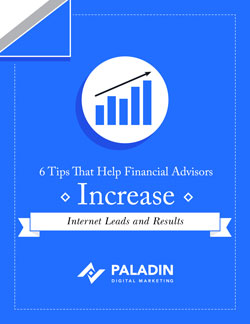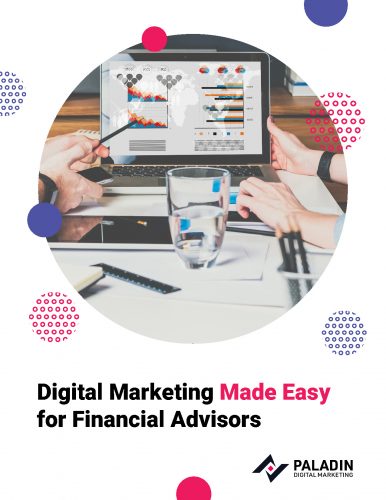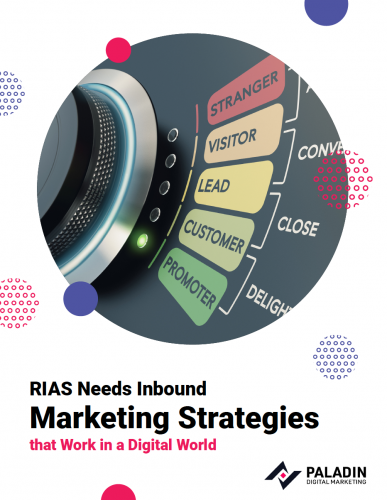Lead Generation For Financial Advisors
When we survey financial advisors about their biggest marketing needs, 82.5% say they do not have enough qualified leads to talk to each month. And, perhaps more importantly, an even bigger percentage say they do not have a cost-effective solution for solving this problem.
A large number of advisors, who responded to the survey, said their only strategy for adding leads is referrals from current clients, friends, and family. Not to be too cynical, but that is tantamount to sitting around and waiting for the telephone to ring. This is not a proactive marketing strategy that produces a steady flow of new leads. In fact, the number of referrals that become revenue-producing clients may not offset an advisor’s annual attrition rate due to death, relocation, terminations, and other reasons.
It is fair to say all advisors have goals, but many of them do not have cost-effective strategies for producing organic growth and positive ROI.
In this article, we are going to explore how various marketing strategies may be a solution for financial advisors who own their brands and websites.
Read our blog article: Top 5 Ways Financial Advisors Can Generate More Leads
Click on any chapter to read more information about that topic:
Why Is Lead Generation So Difficult?
There is a relatively simple answer to this question. Most investors do not want to be contacted. Consequently, they ignore the solicitations of financial advisors. Plus, technologies like Caller ID and spam filters have made reaching investors even more difficult.
Outbound Marketing tactics, like cold calling and direct mail, are close to being rendered obsolete due to the excessive amounts of time and expense and the very low returns. Not to mention rejection rates that approach 100% when advisors try to initiate contact with investors who do not want to be contacted.
It is safe to say there is no easy, cheap, convenient way to generate a steady flow of leads using Outbound Marketing.
What About Inbound Marketing?
Inbound marketing, when investors initiate contact with financial advisors, is definitely a strategy worth considering. It eliminates a high percentage of the rejection that is associated with Outbound Marketing.
The Internet is what makes Inbound Marketing possible. Investors use it to find, research, and contact financial advisors. Rejection rates are substantially lower when investors initiate the process.
Inbound is a superior marketing solution because it fits the way people use the Internet to find information, service providers, and products. Plus, investors tend to be more comfortable when they control the beginning of the process – who they contact for initial interviews.
Who uses Inbound Marketing? Financial advisor firms that own their brands and websites. Inbound Marketing requires a website that investors use to conduct part of their research. The other part is Google searching names, but the end result is the same. Investors end-up on advisor websites to learn more.
Websites are a critical part of the Inbound Marketing process because they convert visitors into qualified leads. This type of marketing does not work for financial professionals unless they are represented on their firm’s website.
Read our blog articles:
How Does Internet Visibility Generate Leads for Financial Advisors?
Websites do not produce their own traffic. Internet visibility produces the traffic that websites convert into qualified leads. It is a pretty simple equation. Investors have to find you on the Internet and be directed to your website.
These investors are drawn to the site to read an article that they found on the Internet. This is the site’s opportunity to convert a visitor into a qualified lead.
We are not talking about just anyone visiting your site and reading blog articles. The best visitors will be your ideal types of clients. For example, you prefer to work with pre-retirees, therefore the visibility you are seeking is for keywords that pre-retirees use on the Internet to find financial information and service providers.
Visibility on the Internet is challenge number one. Getting the right types of investors to your website is challenge number two.
Master the two challenges and you will have a steady flow of leads visiting your website.
Should Financial Firms Generate Leads for Advisors?
Historically, most firms made it the responsibility of financial advisors to generate their own leads. If they wanted to accelerate the growth of their firms, they recruited more advisors. In particular advisors with existing books of business.
The firm may do some institutional advertising to promote the brand, but most firms are not responsible for generating leads for advisors who may be employees or independent contractors.
This creates a paradox. Firms own brands and websites but do not believe it is their responsibility to generate leads for their advisors. Meanwhile, the advisors cannot use Inbound Marketing tactics because they do not own websites.
Perhaps a solution is for firms to use Inbound Marketing to generate leads and the firms’ advisors reimburse the firm for the cost of the lead. This strategy would work best for firms that have high payouts for their advisors who are independent contractors.
Should Financial Advisors Buy Leads?
Financial advisor firms and professionals can produce their own leads, or they can pay a third party to produce leads for them.
Inbound Marketing, referrals, and Outbound marketing are the three ways they can produce their own leads.
If a firm or professional is struggling to produce a steady flow of leads on their own, then buying leads from a third party is definitely a good alternative. It is a quick, economical way to solve the lead generation problem.
There are three key metrics when you buy leads from third parties. What percentage of the leads did you actually get to talk to? What percentage of the leads became active prospects based on mutual interest? What percentage of the prospects became revenue-producing clients?
For example, you purchased 10 leads for $100 each. You talked to five of the leads and one hired you. The new client produced $3000 of annual expense, which was three times higher than the cost of the 10 leads. It can be an effective way to grow a firm if the advisor is skilled at converting leads into prospects and prospects into clients.
Should Advisors Use Advertising?
You have seen the ways the big brands advertise for leads in the major search engines.
They have the deep pockets that are necessary to maintain 18 hour per day exposure for the best keywords.
Many smaller financial advisory firms do not have the marketing budgets to compete with them on page one for hours per day. They may bid a higher click rate fee, but based on the daily spend, the ad may disappear in a matter of minutes and be replaced by an advertiser who pays a lower click rate but has a much bigger daily spend.
Hypothetically, people who click on ads are currently looking for financial advisors. On the other hand, some advisors say they pay for 8-10 clicks to get one conversion (someone who submits data). The other 7-9 clicks do not provide the requested information on landing pages. This becomes a cost of doing business – paying for clicks that do not produce leads.
Facebook advertising is a more affordable alternative for smaller firms. Facebook publishes ads based on demographic data. People who see the ad may or may not be looking for a financial advisor. This reality reduces results but also lowers the cost.
How Do Websites Generate Leads?
Most of the time, financial advisor websites are designed to disseminate information about the firm. They are not designed to produce leads for the firms. That takes a different type of website that is structured to generate new leads.
Let’s assume your Inbound Marketing efforts are producing a steady flow of traffic to your website. Your website has a one-time opportunity to convert these visitors into qualified leads.
The best visitors will be actively seeking financial advisors. They will review the content on the site, and if they like what they see, they will initiate contact to schedule an initial screening call.
The next best visitor is looking for financial information that will help them make financial decisions. One type of information is how to select the best financial advisor. More often, they are seeking information that will help them resolve a financial pain point. They will register to obtain the information they are seeking, so you have their contact information.
The third type of visitor is seeking information about local service providers. They do not contact you and they do not register for a free offer. They are researching advisors they will contact in the future – for example, when they are closer to their retirement dates.

Read our blog article: Want To Be A Billion Dollar RIA? Follow These Tips
The Biggest Mistake Advisors Make When They Generate Leads
Some advisors tell us they have very low close ratios when they follow-up leads. They have trouble reaching the leads, competing with other advisors, converting leads into prospects, and converting prospects into revenue-producing clients.
What many advisors fail to recognize is how cautious investors go about selecting the advisors they want to talk to and eventually hire. They are cautious because they had a bad experience with previous advisors, or this is the first time they have hired an advisor.
One way for investors to exercise caution is to view all of the information that will help them make the right decisions. It starts with visiting the advisor’s website to learn more about the firm. The site will create a first impression and deliver key information that will impact the investors’ selection processes. The website has to be competitive with the other sites that are viewed by investors.
Investors also Google search firm and advisor names. Does what they see confirm that the advisor is a trustworthy financial expert because that is what the investor is seeking.
The big mistake is not managing what investors see on the Internet. What investors see can help financial advisors win new clients or cost them opportunities when investors select someone else.
Can Websites Qualify Leads
This is definitely a two-edged sword. Let’s say your firm has a hard $1,000,000 minimum asset requirement. Website visitors who want to schedule interviews or register for a free offer are routed to a landing page that captures their information.
One of their required fields could be to disclose the amount of money they have available for investment. If the indicated amount is less than your minimum an automatic message is displayed indicating they do not meet your minimum.
Or, the content on your website or landing page discloses your minimum thereby discouraging people with less than your minimum from submitting their contact information or registering for a free offer.
The other side of the sword is do you want to exclude people who may not meet your minimum today but could meet your minimum in the future. For example, their current asset amount is $500,000, but they are retiring in nine months and will be rolling $1.5 million from their 401k account into a rollover IRA. At that point, they will meet your minimum.
We recommend talking to anyone who wants immediate contact and dripping on anyone who registers for one of the offers on your website. You can qualify them during your initial call.
Read our blog article: How Can Financial Advisor Websites Generate More Leads?
Updated 10/10/2021

Read our 6 tips to increase your leads
We provide a few tips to help your financial advisory firm increase website results
Download Now



